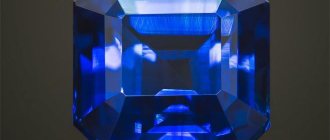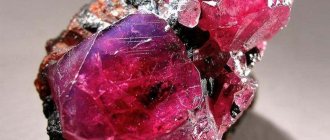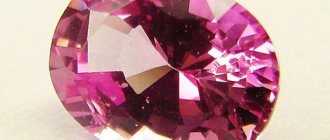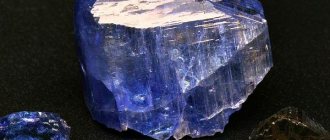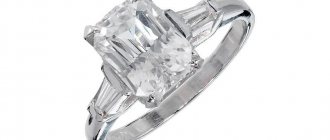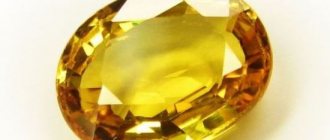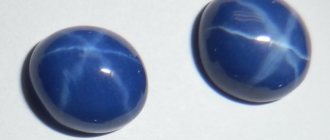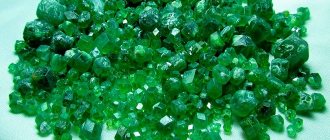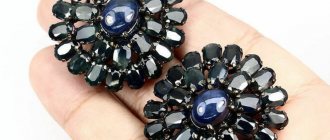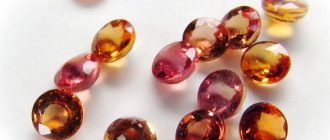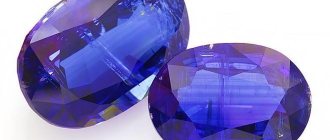| Formula | Al2O3 |
| Color | Blue and cyan in various shades; colorless, pink, orange, yellow, green, purple, black |
| Shine | Glass |
| Transparency | Transparent to opaque |
| Hardness | 9 |
| Cleavage | Absent |
| Kink | Rough to conchoidal |
| Density | 3.95 - 4.00 g/cm³ |
Place of Birth
The most famous sapphire deposits are confined to pegmatites or placers and are located in the USA, Australia, Madagascar, India, Sri Lanka, Vietnam, Burma, Thailand and China.
In Russia there are no large deposits in which sapphire can be mined on an industrial scale: its finds are confined to manifestations of blue corundum, in which transparent stones suitable for cutting are also found.
Blue sapphire is found in the Urals and on the Kola Peninsula (Khibiny). Ural sapphires, as a rule, have a grayish tint, while Kola sapphires have a peculiar greenish tint with a deep cornflower blue color.
We carry out identification
It is impossible to determine the authenticity of a sapphire without special equipment with 100% probability.
The maximum that can be done at home is to distinguish fake glass. To determine authenticity, jewelers use a special liquid in which a real sapphire is kept afloat while other stones sink, a refractometer, an ultraviolet lamp and a number of other special devices.
A natural crystal is practically no different from a synthetic crystal in color, appearance and physical properties. The only guarantee is the reputation of the seller. The purchased stone (no matter whether it is an independent unit or an element of a product with sapphire) must have a quality certificate indicating whether it is synthetic or a natural product. If the stone is natural, then the certificate indicates whether it has been refined or not.
Nowadays, most stones are refined by annealing or other manipulations. These procedures are aimed at improving their quality. An ennobled crystal is not considered a fake, but a note about this should appear in its “passport”.
Checking the authenticity of a sapphire ring
The refined stone is determined by illumination with ultraviolet irradiation. If it has been annealed, it will give a greenish glow in ultraviolet light. Natural sapphire glows white under a lamp.
The main methods of differentiation are aimed at distinguishing blue corundum from glass or other crystals.
- Look the stone up to the light. Sapphire slightly changes its hue when illuminated, when it is turned first on one side or the other to the light stream. This is the phenomenon of dichroism.
- Crystal differs from glass in its increased hardness and sharp, clear edges.
- Tanzanite can be suspected by its reddish tint.
- Kyanite - by the presence of longitudinal stripes.
- Spinel is dark and cloudy compared to sapphire. It is issued only for sapphires of low-value varieties.
Arm yourself with a magnifying glass with tenfold magnification. The structure of the sapphire does not imply the presence of gas bubbles, but inclusions of other materials that were adjacent to it in the rock are very likely. An artificial crystal, which was created as an independent decoration, will not have inclusions. But this method will not help to identify a fake, which was made with the aim of copying natural corundum as accurately as possible. Adding foreign substances in powder form is not difficult for black market chemists.
To determine artificially grown stone, liquid monobromonaphthalene is also used. The sample is placed in this liquid, the vessel is placed on a white background and illuminated from the side. In natural stone, “growth lines” are visible - straight veins. In synthetic ones they are curved.
Checking the authenticity of a sapphire
There are gas bubbles - this is a fake, and of low quality.
Also, using a magnifying glass, you can identify a doublet or triplet - gluing together several plates of blue stone. The sapphire plate is located on top or in the center, other structural elements are glass or cheaper minerals. The gluing line is visible under high magnification.
Blue tourmaline can only be detected using a refractometer - its refractive indices differ, and only slightly. For control, a special liquid is used that holds the sapphire on the surface, but other stones sink in it.
It is impossible to distinguish tourmaline from sapphire at home.
The easiest way to determine the authenticity of a crystal with the effect of asterism is a three-rayed star located, as it were, in its thickness.
The rays of the star consist of inclusions of rutile. If you turn the stone, the location of the real star will visually change, it will “move”. In a fake, the three-rayed star is always visually located in one place; the “shift” effect from changing the viewing angle in imitations is currently impossible to replicate.
Color varieties
Blue sapphire
Blue sapphire
Thanks to its amazing shades, it is the most valuable variety. Its color and color saturation depend on the presence of titanium and iron impurities.
The shade of blue sapphire can be light, almost colorless, or it can be so deep that the stone appears almost opaque.
Such dark sapphires are less valuable. Due to the presence of various impurities, pure and uniform color is quite rare.
But when cut correctly, blue sapphire becomes a real treasure. Sapphires of a special cornflower blue color were found in Kashmir. They can cost more than emerald.
Yellow sapphire
Yellow sapphire
The stone can be of different shades from light yellow to deep amber. Its popularity is slightly less high than that of blue, and the pure color is also quite rare.
Yellows are generally cheaper than blues, but are also widely used in jewelry due to their pleasant warm hue.
Green sapphire
Green Sapphire
The stone does not have such a pure green hue as emerald. Its color is formed by the fusion of yellow and blue areas.
It is valued lower than other types of sapphire. Stones of a greenish hue can be found in the mountains of the Kola Peninsula.
Pink sapphire
Pink sapphire
Rarely found, mainly in deposits of Madagascar and Sri Lanka. It has an amazing delicate shade and successfully replaces a more expensive pink diamond.
White sapphire
White sapphire
The second name is leucosapphire. An absolutely transparent stone, very similar to a diamond. Due to its lower cost, it is sometimes used as a replacement. Interesting effects are achieved in jewelry by combining these stones with each other.
Black sapphire
Black sapphire
An opaque or translucent stone with a noble shine, reminiscent of agate.
The stone is not valued very highly; it is suitable for creating jewelry in a simple style, in jewelry for men. Mainly mined in Australia. Black star sapphires are of particular value.
Star sapphire
Star Sapphire
Star sapphires, sometimes called star stones, have needle-like rutile inclusions in their structure that refract light in a special way.
When properly polished, the light on their surface is refracted in the form of a star-shaped figure. To achieve this effect, the surface of the stone is not cut, but polished, giving it the shape of a sphere or hemisphere.
The price of such crystals depends on their shade and quality of light reflection.
How to determine whether a sapphire is natural or not?
Certificate of Authenticity
Ask the seller to show the certificate of authenticity, which is what all legally sold gemstones typically receive. Blue sapphires most often come to market from Australia and Thailand. Other sought-after crystals are mined in Kashmir, Ceylon and Burma.
If they cannot provide you with any certificate or it indicates any other country other than those listed above, this is a reason to be wary. The document must describe the main characteristics: clarity, color, carat weight, size.
Color
Check the color in good lighting. Blue sapphire has a clear blue color. Beware of unnaturally colored stones. Remember that this is a naturally occurring mineral.
Size
One of the main reasons for the popularity and high cost of sapphires is their rarity. Therefore, a large discount on a fairly large gemstone should raise suspicions. When an offer seems too good to be true, there's a good chance it is.
When cutting natural stones, the main goal is to preserve as much carat weight as possible. Therefore, stones with the correct geometric dimensions are extremely rare.
Synthetic inserts, on the contrary, are made according to an exact standard (2; 3; 4; 5 mm). This is done for ease of setting during mass production of budget jewelry.
Purity
Use a jeweler's loupe or microscope to evaluate cleanliness. Absolutely pure, transparent stones are extremely rare in nature. The presence of dark inclusions and defects in the form of small cracks is a clear sign of naturalness. Synthetic counterfeits are distinguished by high levels of purity and uniform color.
Surface
Check the surface for small scratches. Sapphire is an extremely durable mineral. Natural glass should not have any surface scratches, but on fairly soft glass they appear easily.
Cut
Evaluate the cut and facets of the stone. A fake will most likely have a simple cut with rounded edges. Look for a sapphire with a crisp, clean cut.
Frame
Check the setting of the stone as well. If the setting completely covers the edges or back of the sapphire, it is possible that this was done to hide defects in the sapphire or signs of a fake stone. The fastening quality is high, the insert stands evenly and neatly – a good indicator.
Shop from trustworthy sellers. Ask friends or family to recommend a reliable supplier, and do not be tempted by sudden discounts. Sapphires are very expensive stones, and you should be sure that you are completely satisfied with the jewelry before you decide to purchase.
Synthetic sapphires
Synthetic sapphires
Today, sapphire is in demand in technology and jewelry. First of all, this concerns optically transparent sapphire - leucosapphire. Due to its outstanding hardness and heat resistance, it is widely used as wear-resistant and heat-resistant windows, such as in a variety of mobile gadgets: wristwatches, cell phones.
Sapphire substrates are also used in the semiconductor industry in the manufacture of semiconductor chips and LEDs using silicon-on-insulator technology.
Artificial sapphires were first synthesized in 1904 by French chemist Auguste Verneuil. The synthesis method he used - droplet deposition in an oxygen-hydrogen flame - is now called the Verneuil method. Today this method is also used for the industrial synthesis of sapphires.
Later, the Czochralski method and its variations (Kyropoulos method, Stepanov method) were invented - pulling a crystal from the melt using a seed crystal. Today, this method produces sapphires weighing up to 300 kilograms.
The world produces hundreds of tons of synthetic sapphires per year, mainly in China, Japan, the USA and Russia. One of the world's largest enterprises for the synthesis of sapphires operates in Russia.
The resulting sapphires are cut and polished with diamond tools to the customer's size.
Main uses of artificial sapphires:
- Jewelry making.
- Optics resistant to impact, abrasion, temperature, ionizing and ultraviolet radiation. Including glass for gadgets, armored glass for military equipment.
- Substrates for semiconductor chips using silicon on sapphire technology.
- Substrates for optoelectronic devices based on gallium nitride (GaN). This process is also used to produce blue LEDs, which are used to make white LED lighting.
- Additive-activated working fluid for solid-state lasers.
The magical properties of sapphire
Ring with black sapphire
Sapphire has the ability to accumulate cosmic energy.
It helps to find harmony and integrity in life. It is of particular importance for those who want to find their way, find inner comfort, and get rid of depression.
For a person who is too prone to unnecessary rushing, sapphire will be an excellent assistant in establishing internal balance.
It fuels creativity and brings inspiration. The protective properties of sapphire are widely known.
It cleanses space from any negative energy, so its wearer is not subject to the evil eye and damage. The pure color of sapphire symbolizes the honesty, fidelity, and chastity of a woman.
The stone is used to make amulets against the evil eye and talismans, symbolizing the radiance of the mind, spiritual purity and wisdom.
The magic of sapphire depends on its color:
- Yellow is a particularly strong protection against damage, the evil eye, slander, as well as internal uncertainty and anxiety. Gives determination, attracts creative ideas, relieves depression. Anxious people are not recommended to wear this stone constantly, because... it can lead to inner restlessness.
- Blue is the best talisman for those who have problems with the cardiovascular system. Relieves inflammation and headaches. Allows you to collect your thoughts and tune in to a positive wave. Designed for those who want to always achieve their goals.
- Light blue helps you feel the energy of higher powers and reveal magical abilities.
- Black is the best talisman that prevents depression, can restore taste and interest in life, and restores self-confidence. It is a good talisman against dark forces.
- White sapphire allows you to regain faith in yourself, show your inner potential and achieve success. This is a symbol of fidelity and purity, which can be a good gift as a sign of your feelings for your loved one.
- Green helps with sleep problems, develops kindness, compassion, and empathy in people. Helps with eye diseases.
- Pink sapphire – you need to be careful with this stone, because... it helps to materialize thoughts. If you keep a thirst for profit in your soul, anger, envy, dark thoughts can materialize and hit the bearer of this stone. But if your thoughts are bright and your goal is noble, pink sapphire will definitely help you realize it.
Star sapphire has special magical powers, which accumulate energy at the intersection of light rays.
It must be remembered that any sapphire with color defects can lead to the opposite effect, bringing suffering and trouble to a person.
Certificate for sapphire
In the photo: expert opinion on sapphire from the GRS laboratory
In addition to natural origin, sapphires can also be of synthetic origin. They are grown using various methods. They may have good color and excellent clarity, but their value is usually very small, because... unlike natural ones, they are not rare. To confirm the natural origin, as well as diagnose refining, determine the deposit and the relationship to the “top” color, it makes sense to request expert opinions from independent gemological laboratories from sellers of expensive sapphires. Some of the most reputable laboratories include: GIA, Gubelin Gem Lab, SSEF and AGL. In the Asian market, expert opinions from the famous Swiss laboratory GRS are also very popular when selling. In Russia, for diagnostics of sapphires, you can contact the Gemological Center of Moscow State University.
“Practical advice. Check with the seller about the availability of an expert opinion or certificate. Where was the sapphire mined? Has it been gentrified? If yes, then in what way? An expert opinion will help answer these questions. Find out as much information about the stone as possible from the seller. Please note that individuals can buy unmounted blue sapphires in Russia only if the stone has a Russian certificate (not an expert opinion).
Healing properties
Raw sapphire Madagascar
People wearing a pendant inlaid with sapphire on their chest do not have to worry about the condition of the heart and blood vessels. The stone also has a positive effect on the endocrine system.
But not only does the blue crystal affect the heart and metabolism, it helps in the treatment of insomnia and mental disorders. In order for the gem to relieve sleep disturbances and nightmares, it should be placed under the pillow before bed.
But mainly the mineral affects the mental state of a person. It increases his intellectual abilities. Gives the owner a thirst for life, teaches him to cope with neuroses and depression.
And sapphire is the stone of those people who live long. It protects the owner from brain diseases, helps maintain clarity of mind until old age and live a long and happy life.
Modern medicine casts doubt on the ability of minerals to treat certain diseases, but the experience of our ancestors proves the opposite.
Jewelry inlaid with sapphires is chosen to last forever. They become a family heirloom and are passed on from generation to generation. Products such as good wine become more and more expensive every year.
Areas of application
Ring with star sapphire
The main use of sapphire is jewelry. In addition, there are other areas of application of the mineral. It depends on the appearance and purity of the gem. Sapphire purity is a characteristic that reflects the transparency of the mineral on a scale from 1 to 4:
- 1 – transparent, tiny inclusions do not deteriorate the appearance;
- 2 – transparent, the color is saturated, the defects are larger, but not visible under a magnifying glass;
- 3 – opaque, inclusions visible to the naked eye;
- 4 – slightly transparent, cloudy, indefinite color, many defects.
Transparent and translucent minerals go to jewelers. Lower quality and lab grown stones, especially clear ones, are used in the technical industry. They are made from:
- parts in ophthalmic instruments;
- substrates for microcircuits;
- glass for airplanes, helicopters, rockets;
- glass slides;
- inserts in cameras;
- glasses for gadgets, watches.
Jewelry with sapphire
Products with precious sapphire inserts have been highly valued at all times. Today, leading jewelry houses use corundum both in individual products and in entire collections. Sapphires with step or diamond cuts, as well as “star” stones with cabochon cuts, look especially elegant. When combined with topazes, amethysts and emeralds, blue sapphires acquire new colors.
The classic combination of sapphires and diamonds, which has become a symbol of luxury, is still relevant. Blue sapphires always look spectacular when set in white or yellow gold. At the same time, complemented by a combination frame, the classic duo of precious stones sounds fashionable and modern.
The trend is for models with “fantasy” sapphires in delicate shades, which give the products a special sophistication. The combination of many bright “fantasy” stones in one piece allows you to bring to life the most daring design ideas.
A piece with sapphires is not only a stylish addition to any look, but also an indicator of impeccable taste. Kate Middleton, Penelope Cruz, Carrie Underwood, Heidi Klum, Jessica Simpson, Katie Holmes and others shine in jewelry with these precious stones.
Story
Like ruby, sapphire belongs to the corundum group. The modern name of the stone comes from the Old French saphir. This is a direct borrowing from Latin or the ancient Greek "sappherios". In both cases the word is translated as “blue stone.”
Many facts suggest that, most likely, sapphires were originally called lapis lazuli, and the stone that is now called sapphire could have been called “yakinthos” or “hyacinth” by the Greeks, although this cannot be said with certainty.
The ancient Russian name for sapphire is “azure yacht”.
At a jewelry exhibition in 2008 in Dubai (United Arab Emirates), the public was presented with a sapphire cut into a plate measuring 5.8 by 9.8 mm, on which 10,000 lines of the Holy Quran were applied in white gold and platinum. The sapphire was valued at 15,000 dirhams, or $4,167, and was intended to be used in wedding jewelry.
The French poet and Christian scientist Marbaud of Rennes, famous in the Middle Ages, in his book “Precious Stones” pays special attention to sapphire, placing it above all other precious stones. For the similarity of the color of the stone with the clear sky, as well as for its special properties that supposedly help to distinguish any deception and clarify unclear prophecies, he calls the stone “sacred.” Thanks to Marbodius, from the 12th century. sapphire begins to enjoy great popularity among Catholic clergy.
The most valuable color of sapphire is blue. Another shade, which is also very valuable, is called “Lotus flower”, or “padparadsha”. The name comes from a slightly modified Sanskrit "padmaragaya", where "padma" means "lotus" and "raga" means "flower". “Lotus Flower” is little known to the Russian buyer, since it is extremely rare and is not found in mass-market products at all.
In addition to these two most expensive shades, sapphires also exist in nature in other colors: yellow, orange, green, pinkish-red, purple. There are even stones that are completely colorless, and those that change color depending on daytime or evening light, that is, with the alexandrite effect.
The most expensive sapphires in the world are Kashmiri. They were mined for only 15-20 years at the end of the 19th century. In the northwestern Himalayas. There are no modern Kashmir sapphires, since the deposit was completely depleted at the beginning of the 20th century.
In the family of Her Majesty Queen Elizabeth II of Great Britain, sapphires have always been given due attention, so it is not surprising that both Princess Anne and Princess Diana received sapphire rings during their engagement to their lovers. Sapphires are mined in many countries around the world: Afghanistan, Australia, Vietnam, India, Cambodia, Kenya, China, Laos, Madagascar, Malawi, Myanmar, Nepal, Nigeria, Pakistan, USA, Tajikistan, Tanzania, Thailand and Sri Lanka.
How much does sapphire cost?
Earrings with sapphire and diamonds
The cost of sapphire is influenced by color. Next, the location of extraction, purity/transparency, and weight are taken into account. It is being clarified whether it has been ennobled.
The most expensive is the blue stone. It is assessed by location and weight.
Prices for “Burmese” sapphires:
- 1-3 carats - 3.8-9.4 thousand dollars per carat;
- 4–10 carats – 9.7–17 thousand dollars per carat;
- from 11 carats - 18–27 thousand dollars per carat.
The cost of other stones is determined by weight (thousand dollars per 1 carat):
- padparadscha - from 2.4, a large specimen (larger than 5 carats) is considered a collectible, costs from 31 thousand dollars per carat;
- pink - 0.9–6.5;
- yellow - 0.7–3.6;
- star blue - 0.7–3.4;
- orange, purple, alexandrite - 1100–2200;
- colorless - 0.2–0.4;
- green - from 0.06;
- black - 0.003–0.01;
- star black - 0.05.
Substandard stones are valued not by carats, but per stone - $10–20.
How to recognize a fake
Glass imitations are usually sold under the guise of sapphire. Artificial gems are not fake; they meet all the chemical, physical and external characteristics of natural stones. A sign of a laboratory mineral is that there is a growth zone (a stripe of a more saturated color inside the gem).
Here's how you can tell a real sapphire from an imitation one at home:
- Natural stones contain inclusions in the form of dots and dashes, this can be seen through a magnifying glass. Artificial specimens do not have them, but they are much more expensive than glass fakes.
- The gem is very hard and resistant to external influences. If you run it across the glass, it will leave a scratch on the glass.
- Sapphire is cool. Glass heats up faster in the palms.
Stone strength
The authenticity of natural stone is evidenced by its strength. Thus, in terms of strength characteristics, sapphire can only be compared with diamond. Due to its high strength, the edges of corundum will always be even and smooth. And if you are not afraid and run a sharp object over it, then no trace will remain on the surface of the stone.
But no one will allow you to do such a manipulation in a store, so before choosing a sapphire, ask the seller for a corundum quality certificate.
When reading the certificate, check whether the purity level is indicated - IF. If it is present, then the stone is clearly a fake - this indicator is not determined in genuine sapphires.
How to care for stone
Many jewelry owners have experienced the frustration of having their favorite pieces damaged. Some stones have very low strength and split from a slight blow, others do not tolerate contact with chemicals.
As for sapphire, it is more durable. Its hardness is 9 out of 10 on the mineralogical scale, so sapphire jewelry does not need to be stored in a separate padded box. Wash them with soap every few months and then leave them to dry naturally. In summer, it is recommended to repeat this procedure somewhat more often.
Cleaning jewelry with soap is different from regular hand washing. Jewelry should not be rubbed against soap, otherwise its particles will become clogged with uneven surfaces and will then be difficult to wash. Use soapy water for cleaning. To make it, lather the soap in a plate or cup.
How to wear it correctly
Products with small sapphires can be worn in everyday life, but large stones are best left for special occasions. Owners of jewelry with such a gem need to consider several factors:
- deep blue stones are better suited for brunettes and older women;
- blondes and young girls harmonize well with light jewelry;
- for the office or everyday activities, it is better to choose modest jewelry; the frame can be silver or white gold;
- dark stones in massive rings and cufflinks are well suited for business men.
It is better to buy sapphires on the 8th lunar day. After purchasing, the jewelry should not be worn immediately. It is better to wait until 22 lunar days.
Color rating
Everyone knows that sapphires are blue stones, but their color palette is much wider. The color of real sapphires varies from pink-orange to dark purple, almost black shades. But the most valuable are still bright blue stones, which get their color thanks to the admixtures of iron and titanium in a certain proportion. Pinkish-orange sapphires in the east are called “padparadscha”; their shade is compared to the color of lotus petals and is also rated quite highly.
Some stones can change color in artificial light, like alexandrites. This phenomenon is called pleochroism and is characteristic mainly of colored sapphires.
Jewelers divide blue stones into two types:
- royal, with a rich dark blue hue;
- cornflower blue, bright blue.
In our country, cornflower blue sapphires, which look spectacular in the rays of the dim northern sun, are more valuable than others, while in countries located close to the equator, darker royal crystals are preferred.
The color of blue stones is determined according to a standard scale, where the highest quality example is the pure cornflower blue hue of Kashmir sapphires. There are three categories of evaluation: for each stone, its tone, color saturation and lightness are determined in accordance with standard tables. To sell jewelry, jewelers use a simplified classification, dividing minerals into bright, rich and light blue stones.
On jewelry tags and in certificates where the quality of a precious mineral is indicated by a fractional number, the color rating appears in the numerator. The lower the number, the higher the stone's rating.
What stones does it go with?
Ring with sapphire
Sapphire loves to be the soloist in jewelry on her own, without the need for neighbors. This precious mineral absolutely does not tolerate the proximity of Earth stones (opaque minerals), since they are often too cheap.
Sapphire does not combine with beryl or malachite. This applies to proximity not only in the product, but in the image as a whole.
It is not recommended to wear sapphires with pearls - these minerals conflict both stylistically and energetically.
The best combination is considered to be a tandem with ruby, diamond, garnet, cubic zirconia and amethyst.
